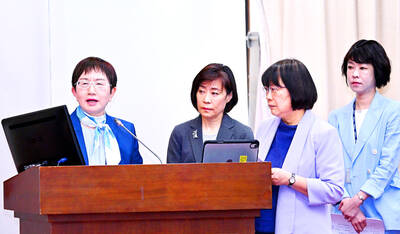Largan Precision Co (大立光) yesterday reported a 38.67 percent increase in consolidated revenue for last month from a year earlier to NT$5.44 billion (US$179.5 million), the highest level for March in the company’s history.
Last month’s figure also grew 48.26 percent from February, ending three consecutive months of sequential losses, company data showed.
ORDERS CONTINUE
The Taichung-based company is the world’s largest supplier of handset camera lenses, focusing on high-end products for Apple Inc’s iPhone and Android phone vendors, such as Huawei Technologies Co (華為) and Samsung Electronics Co.
Largan last month benefited from pull-in orders related to the iPhone SE2, Samsung’s Galaxy S20, Huawei’s P40 and other new handset models, analysts said.
However, as the COVID-19 pandemic spans the world, revenue growth might weaken this month, they said.
"Given 98 percent of Largan’s revenue is from smartphones, it will be a tough year for the company, as the smartphone industry will likely face both a shipment decline and product mix weakness in 2020," Yuanta Securities Investment Consulting Co (元大投顧) said in a note yesterday.
Largan’s 20-megapixel lenses and high-end models, which command higher prices, accounted for 20 to 30 percent of its total sales last month, while its 10-megapixel lenses made up 40 to 50 percent and 8-megapixel lenses 10 to 20 percent, the company said in a statement.
First-quarter consolidated revenue increased 34.52 percent from last year to NT$13.21 billion, higher than Capital Investment Management Corp’s (群益投顧) NT$11.94 billion estimate.
However, revenue fell 28.02 percent from the previous quarter due to lower pull-in orders from Chinese phone brands amid the pandemic, as well as the low-season effect last quarter, Capital said in a note.
Largan is to release its earnings results for the first quarter at an investors’ conference on Thursday, and give sales guidance for the second quarter, as well as the company’s dividend policy after it posted record earnings per share last year of NT$210.69.
As the firm’s capacity utilization rate declined, first-quarter gross margin is estimated to fall 5.27 percentage points quarter-on-quarter to 65.85 percent and net profit is forecast to decline 31.2 percent to NT$5.57 billion, or earnings per share of NT$41.52, Capital said.
Largan shares on Wednesday fell 1.83 percent to NT$3,760 in Taipei trading. They have dropped 24.8 percent this year, Taiwan Stock Exchange data showed.
This story has been updated since it was first published.

‘SWASTICAR’: Tesla CEO Elon Musk’s close association with Donald Trump has prompted opponents to brand him a ‘Nazi’ and resulted in a dramatic drop in sales Demonstrators descended on Tesla Inc dealerships across the US, and in Europe and Canada on Saturday to protest company chief Elon Musk, who has amassed extraordinary power as a top adviser to US President Donald Trump. Waving signs with messages such as “Musk is stealing our money” and “Reclaim our country,” the protests largely took place peacefully following fiery episodes of vandalism on Tesla vehicles, dealerships and other facilities in recent weeks that US officials have denounced as terrorism. Hundreds rallied on Saturday outside the Tesla dealership in Manhattan. Some blasted Musk, the world’s richest man, while others demanded the shuttering of his

ADVERSARIES: The new list includes 11 entities in China and one in Taiwan, which is a local branch of Chinese cloud computing firm Inspur Group The US added dozens of entities to a trade blacklist on Tuesday, the US Department of Commerce said, in part to disrupt Beijing’s artificial intelligence (AI) and advanced computing capabilities. The action affects 80 entities from countries including China, the United Arab Emirates and Iran, with the commerce department citing their “activities contrary to US national security and foreign policy.” Those added to the “entity list” are restricted from obtaining US items and technologies without government authorization. “We will not allow adversaries to exploit American technology to bolster their own militaries and threaten American lives,” US Secretary of Commerce Howard Lutnick said. The entities

Minister of Finance Chuang Tsui-yun (莊翠雲) yesterday told lawmakers that she “would not speculate,” but a “response plan” has been prepared in case Taiwan is targeted by US President Donald Trump’s reciprocal tariffs, which are to be announced on Wednesday next week. The Trump administration, including US Secretary of the Treasury Scott Bessent, has said that much of the proposed reciprocal tariffs would focus on the 15 countries that have the highest trade surpluses with the US. Bessent has referred to those countries as the “dirty 15,” but has not named them. Last year, Taiwan’s US$73.9 billion trade surplus with the US

Prices of gasoline and diesel products at domestic gas stations are to fall NT$0.2 and NT$0.1 per liter respectively this week, even though international crude oil prices rose last week, CPC Corp, Taiwan (台灣中油) and Formosa Petrochemical Corp (台塑石化) said yesterday. International crude oil prices continued rising last week, as the US Energy Information Administration reported a larger-than-expected drop in US commercial crude oil inventories, CPC said in a statement. Based on the company’s floating oil price formula, the cost of crude oil rose 2.38 percent last week from a week earlier, it said. News that US President Donald Trump plans a “secondary